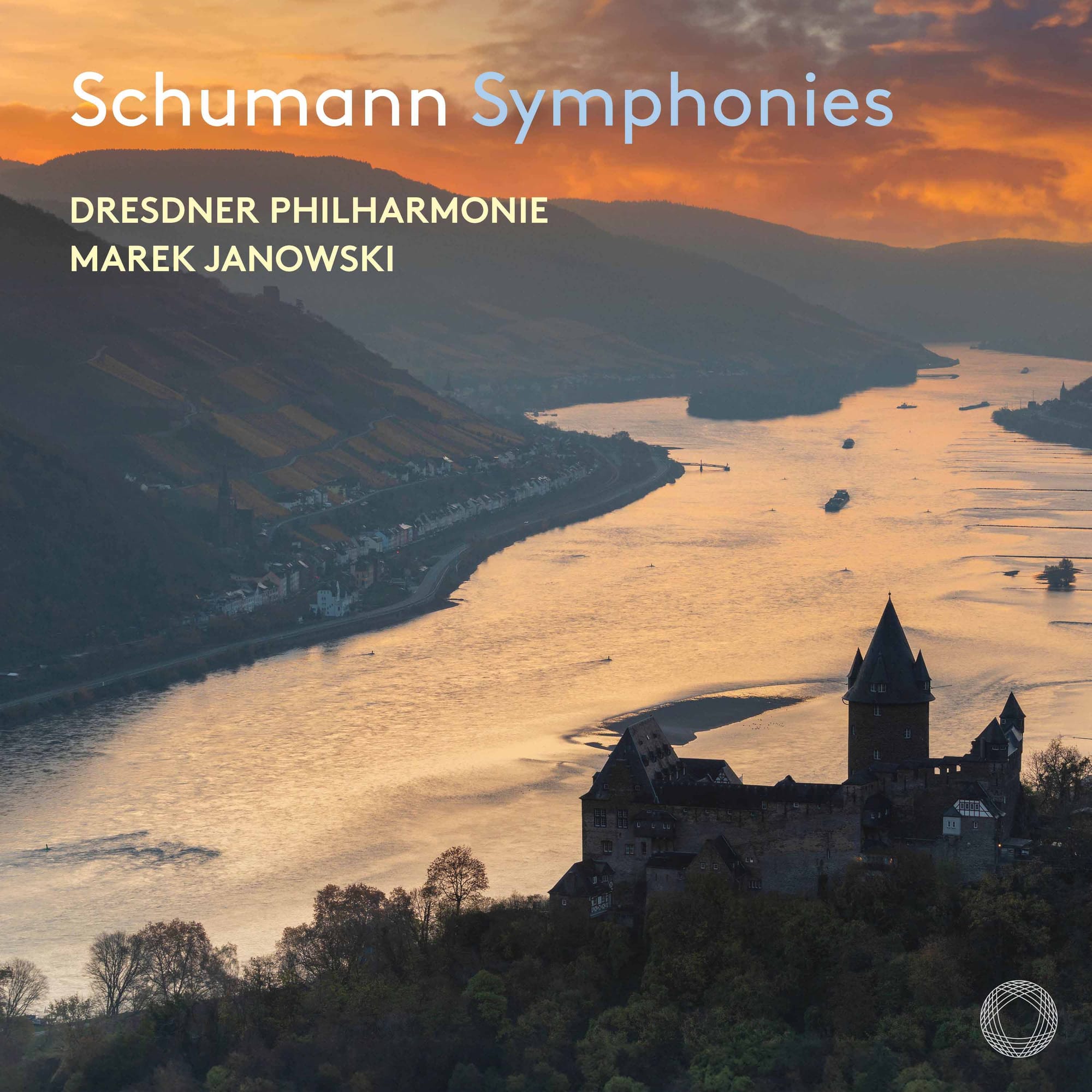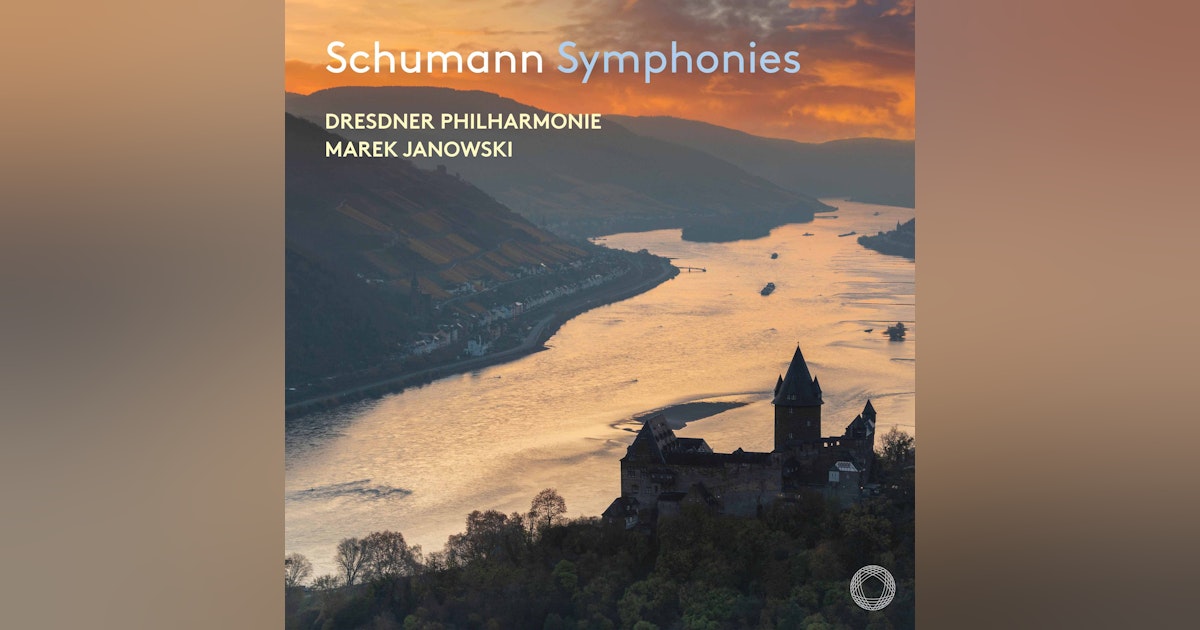
Timed to coincide with a trip to Dresden for Walküre with Nagano, here is yet more evidence of the gold that lies in that beautiful cty. The Dresden Philharmonic under Janowski provide a stunning set of Schumann Symphonies (1-4 – no Overture Scherzo and Finale). Performances are a phenomenal combination of lithe, detailed and yet presented in the warm orchestral sound so characteristic of this region.
So it is that the First Symphony, the so-called “Spring,” finds both rhythmic propulsion and solid German depth in its first movement: the opening fanfares speak of matters of great import, the orchestral arrival around eight minutes in is grand, majestic. The Dresden strings have great body of sound and yet are so lithe, while the recording admits each and every detail:
The two central movements contrast beautifully: the flow of the Larghetto, the verve of the Scherzo (with its two trios). The woodwind in the third movement are delightful:
The finale poses its own problems, not least extremely high and fast violin figures (superbly performed by the Dresdeners). Janowski finds great contrasts here, not just in terms of dynamic, but in terms of articulation also. The moment when Schumann stops everything, and horns and flute invoke Nature (particularly via the horn call) is beautiful:
This Schumann “Spring” has everything, and now – for his writer at least – takes its place on the top of the pile, over Muti, Sawallisch, et al.
The least recognised of the four symphonies, No. 2 in C-Major, Op. 61, is a gem, and there can be few symphonies that open as beautifully. The fateful but simple fanfare motif sings out clearly on trumpets in this performance; Janowski dares to present Schumann’s gestures as almost separate entities at times, and it works perfectly. It should come as no surprise that this symphony has had its champions in the past, most notably perhaps Toscanini. But just listen to the fateful fanfares in the first movement and how Janowski works so intelligently with Schumann’s use of gesture:
The different sections of the Scherzo (which is placed second) are beautifully juxtaposed, but the most notable movement is surely the slow movement, an Adagio espressivo of extraordinary depth. Listen to the aching first theme and how beautifully the Dresdeners project its yearning core (and then the magical oboe/bassoon Duttons):
This slow movement is a plateau of extraordinary grace; the finale could hardly contrast more. The upward gessoes of the theme remind me of Mendelssohn’s “Italian” symphony first movement, but cast in Schumann’s individual terms:
As a little insert, I mentioned Toscanini before in the Second. He didn’t excel in everything but he did in this, and the NBC 1946 is widely acknowledged as his best:
The so-called “Rhenish” Symphony, No. 3 in E flat-Major, Op. 97 (1850), is the most famous of the four symphonies given that No. 4 was effectively composed earlier, it may be considered the last, and most mature, of the four. That combination of detail and grit, plus Janowski’s clear grasp of the overall structure, pays huge dividends here. Accents bite, and the flow is unstoppable:
Janowski’s take on the second movement is fascinating in that the tension never lets go. even with the lovely horn and wind passages (superb first horn up to that top B natural!), Jurowski ensures the bass motion stops us from fully relaxting:
Pastoal relaxation only comes with the this movement really, here an absolute joy:
Inspired by the move of an archbishop to cardinal (specifically the ceremony for that shift), the fourth movement exudes noble procession and deep solemnity (if you look at the score, Schumann notates it so it almost looks like a piece of Renaissance choral music. the brass are phenomenal here, as a unit:
Janowski reminds us that the finale of the “Rhenish” is not too far removed from the fresh, vernal world of the First Symphony, and the precision often Dresden Philharmonic stings is remarkable:
So to Symphony No 4, D-Minor, Op. 120, written in 1841 but revised in 1851 – performances of the original are rare but I do remember a Proms performance back in 2006 (Northern Sunfonia, Thomas Zehetmair). Here we have the late version in a fine performance. Janowski just avoids letting the tension sag in the first move development section. Again, that detail helps enormously:
The oboe and solo cello melody of the second movement is lovely; even more glorious is the approach to the cadence thereafter, with the strings:
Janowski makes clear the correspondences between this movement and the slow opening of the symphony superbly. The solo violin has an important part to play in this movement, not least in the triplet decoration of the melody – here it is Wolfgang Hentrich:
Plenty of energy again for the Scherzo – a gruff determination to the Scherzo proper – before a properly exultant finale:
A really significant release, then, one to cherish. The recording itself, in Dresden’s Kulturpalast, is top rank, and the SACD sound really delivers. A real winner.
This wonderful set can be purchased at Amazon here; Spotify and iDagio below.










